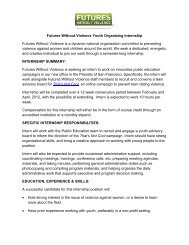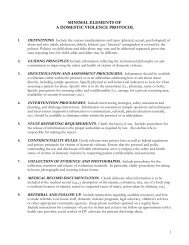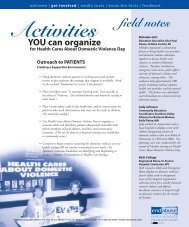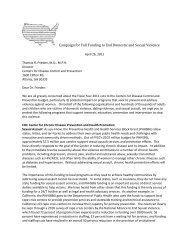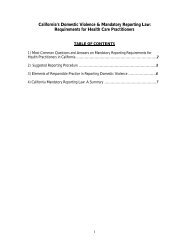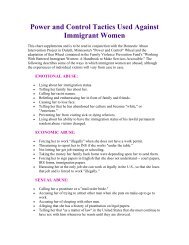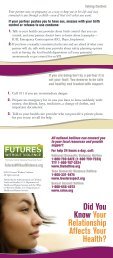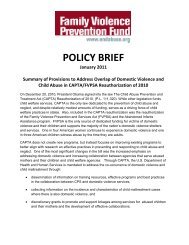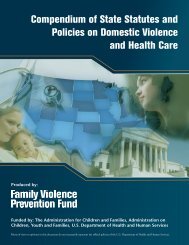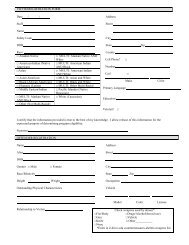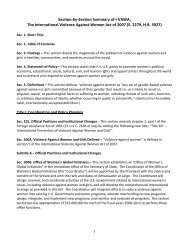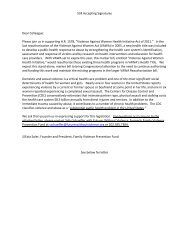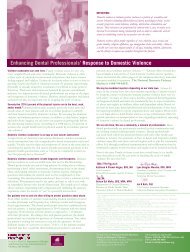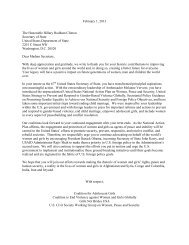Hanging Out or Hooking Up: - Futures Without Violence
Hanging Out or Hooking Up: - Futures Without Violence
Hanging Out or Hooking Up: - Futures Without Violence
Create successful ePaper yourself
Turn your PDF publications into a flip-book with our unique Google optimized e-Paper software.
<strong>Hanging</strong> <strong>Out</strong> <strong>or</strong> <strong>Hooking</strong> <strong>Up</strong>: Clinical Guidelines on<br />
Responding to Adolescent Relationship Abuse<br />
14 FUTURES WITHOUT VIOLENCE<br />
“It got so bad, I tried to kill myself. I tried jumping off<br />
the bridge, and stuff like that; ‘cause I just couldn’t<br />
deal with it anym<strong>or</strong>e. I couldn’t deal with it. I stopped<br />
talking to all my friends. I had a ton of friends from [my<br />
hometown], and I wasn’t allowed to talk to any of them.” 37<br />
Teen Pregnancy Risks<br />
Although a myriad of teen pregnancy prevention programs have been<br />
developed at state and local levels, few directly address the connection between<br />
ARA and pregnancy risk, <strong>or</strong> recognize the identification of one of these risks<br />
as a clinical indicat<strong>or</strong> to screen f<strong>or</strong> the other. A large body of research points to<br />
the connection between ARA and teen pregnancy:<br />
• Adolescent girls in physically abusive relationships were 3.5 times m<strong>or</strong>e<br />
likely to become pregnant than non-abused girls. 38<br />
• Adolescent mothers who experienced physical abuse within three months<br />
after delivery were nearly twice as likely to have a repeat pregnancy within<br />
24 months than non-abused mothers. 39<br />
• Among teen mothers on public assistance who experienced recent ARA,<br />
66% experienced birth control sabotage by a dating partner. 40<br />
“He was like, ‘I should just get you pregnant and have a<br />
baby with you so that I know you will be in my life f<strong>or</strong>ever.’<br />
It’s just like, f<strong>or</strong> what, you want me to not go back to school,<br />
not go to college, not want me to do anything just sit in the<br />
house with a baby while you are out with friends.” 41<br />
Condom Use<br />
Numerous studies have linked IPV<br />
victimization with inconsistent<br />
condom use <strong>or</strong> a partner refusing to<br />
use a condom. 42,43,44,45,46 In a literature<br />
review on relationship violence,<br />
condom use and HIV risk among<br />
adolescent girls, physical partner<br />
violence was routinely associated with<br />
inconsistent <strong>or</strong> non-condom use. 47<br />
Adolescent boys who perpetrate dating violence are less likely to use condoms, particularly in steady<br />
relationships, 48 while girls experiencing dating violence are half as likely to use condoms<br />
consistently compared to non-abused girls. 49 The connection between IPV and not using condoms<br />
is not limited to physical violence. In a national study of adolescents, girls’ current involvement in<br />
verbally abusive relationships was associated with not using a condom during the most recent sexual<br />
intercourse. 50<br />
-19 year old female<br />
Sexually Transmitted Infections (STIs)/HIV Risks<br />
Many STI/HIV prevention and intervention programs focus on condom education. However, condom<br />
negotiation may not be possible f<strong>or</strong> young women in abusive and controlling relationships. Requests f<strong>or</strong><br />
STI testing may be a clinical indicat<strong>or</strong> to screen f<strong>or</strong> ARA.<br />
• Lack of control over contraception and fear of condom negotiation, coupled with coercive <strong>or</strong> f<strong>or</strong>ced<br />
unprotected sex increases risk f<strong>or</strong> HIV and other STIs in abused adolescent females. 51




